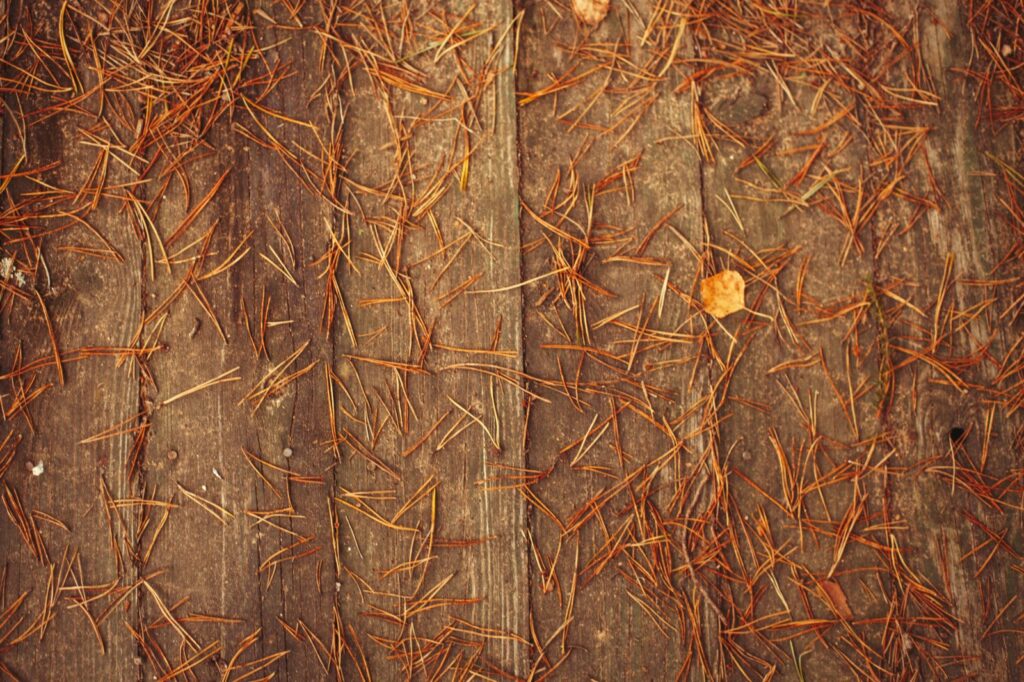
Do Pine Needles Kill Grass? (Explained)
Anyone with pine trees knows what it’s like to have those needles cover their lawn.
While they might not look too concerning at first, pine needles can actually cause problems for your grass over time if you don’t take care of them.
In this post, I’ll explain how they affect grass, and if pine needles can kill grass.
How Pine Needles Affect Grass
There’s quite a bit going on when pine needles pile up on your lawn, and none of it helps your grass grow well. Let me explain:
Blocks Water And Nutrients
The biggest problem with pine needles is that they get in the way of water and nutrients trying to reach your soil.
As pine needles fall and pile up, they form a dense mat on top of the grass. This mat prevents water from penetrating the soil, meaning your grass doesn’t receive the hydration it needs.
The needles also keep air from moving around in the soil properly.
Your grass roots need that air to stay healthy! When the soil gets packed down without enough air, it’s even harder for the grass to get the nutrients it needs.
Without enough water and nutrients, your grass won’t grow well and some spots might die off.
Also Read: Will Lime Kill New Grass Seed?
Blocks Sunlight
Your grass needs sunlight to make its own food through photosynthesis.
When you’ve got a thick blanket of pine needles on your lawn, the grass underneath can’t get enough sun to do this properly. This makes the grass grow weak and unhealthy.
This is especially tough for grass growing in shady spots under pine trees where lots of needles tend to gather.
After a while, areas that don’t get enough sun start thinning out or turning into bare patches.
Competes For Moisture
Pine needles don’t just block water – they actually take some of it for themselves. As the needles break down, they pull moisture away from the grass.
This becomes a real problem during dry spells when there isn’t much water to go around.
Your grass needs the moisture in the soil to stay healthy, but that thick layer of pine needles keeps taking what little water there is.
If the soil is already dry, having pine needles on top just makes things worse for your grass.
Lowers Soil’s pH
Pine needles are naturally acidic, and over time they can make your soil more acidic too.
Most grass likes neutral soil (with a pH around 6 to 7), so when things get too acidic, the grass has trouble getting the nutrients it needs. The acid levels can also hurt the good bacteria and other tiny organisms in your soil that help keep your lawn healthy.
As the soil gets more acidic, some types of grass just can’t grow well there anymore, and in really bad cases, they might die off.
Also Read: Is It Too Late To Treat Grubs?
Can Pine Needles Kill Grass?

Pine needles won’t kill your grass overnight, but they can definitely hurt it over time, and yes, sometimes they can end up killing it.
If you let pine needles pile up for too long, they create conditions that make it really hard for grass to survive. When grass is going to have a very tough time.
The grass under thick piles of needles, especially in shady areas, might not even make it.
But here’s the good news – if you clean up those pine needles regularly and take care of your lawn, your grass should be fine.
How To Remove Pine Needles From Lawn
The best way to keep pine needles from damaging your lawn is to clean them up regularly.
There are several ways to do this, and each one works better in different situations, depending on how many needles you’re dealing with and how big your yard is.
Let me explain:
1. Raking
Raking is probably the most common way to get rid of pine needles.
You’ll want a leaf rake, and there are even special ones made just for pine needles – they have flexible tines that pick up the needles without hurting your grass.
It’s best to rake regularly, especially in fall when pine trees drop most of their needles. And try to rake when the needles are dry – wet needles just stick together and make the job harder.
Sure, raking takes some work, but it’s a great way to make sure your grass can get the sunlight and water it needs.
2. Using A Lawn Sweeper
If you’ve got a big yard or lots of pine needles, a lawn sweeper can make your life easier.
These machines have brushes that spin around and sweep pine needles and other stuff into a collection bin. You can get ones you push or ones you can pull behind a riding mower.
They are great for cleaning up big areas quickly, and they’re not as hard on your back as raking.
Plus, they’ll pick up leaves and other yard debris too, so they’re pretty handy to have around.
Also Read: Too Much Lime On Lawn
3. Using A Leaf Blower Or Vacuum
A leaf blower or vacuum can work well for dealing with pine needles.
Leaf blowers are great for pushing the needles into piles, and they can reach spots that might be tricky to get to with a rake, like along fences. If you go with a vacuum, some of them come with bags to collect the needles and other yard waste.
Blowers work best in open areas, while vacuums are good for smaller spaces.
Just be careful not to blast the air too hard at your grass – you don’t want to damage it.
4. Mowing Over Pine Needles
Sometimes you can just mow over pine needles to break them up.
If you don’t have too many needles on the ground, a mulching mower can chop them into tiny pieces. These pieces will eventually break down and add some good stuff to your soil.
But this only works if the layer of needles isn’t too thick or wet – otherwise, you might clog up your mower or the needles won’t break.
This method works best when your lawn is healthy and you’re not dealing with too many needles.
5. Hand Picking Or Using A Rake With A Bag Attachment
For small areas or spots with just a few pine needles, you might want to pick them up by hand or use a rake with a bag attached.
This gives you more control and works well for those tough-to-reach places where bigger equipment just won’t fit.
Hand picking is also good for cleaning up around flower beds or garden paths.
A rake with a bag makes it easy to collect and get rid of them without making a mess.
What to Do With Dead Pine Needles

Once you’ve cleaned up all those pine needles, you might wonder what to do with them. They’re pretty acidic, so they don’t work in every compost pile, but you can still use them in other ways.
One option is to spread them around as mulch in your garden.
Put a thin layer around your plants, flowers, or trees – they’ll help keep moisture in the soil, stop weeds from growing, and even provide some protection when it gets cold.
You can add them to your compost pile too, just make sure to mix them with other stuff like grass clippings or leaves to balance out the acid.
If you don’t want to use them for anything, you can always put them in yard waste bags or take them to a place that recycles yard waste.
Bottom Line
Pine needles won’t kill your grass right away, but they can cause damage if you let them pile up.
They block water, cut off sunlight, and make the soil too acidic – and all of that can eventually kill your grass if it gets bad enough.
The best thing you can do is to get rid of those pine needles regularly.








